Roger M. Wakimoto, an associate director and senior scientist at the National Center for Atmospheric Research (NCAR) in Boulder, Colorado, and an elected Fellow of the AMS, has been named NCAR’s new director. He succeeds Eric J. Barron, who left NCAR this month to assume the presidency of Florida State University. Wakimoto will assume his new position on February 1.
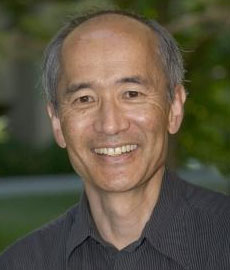
“Roger is a world-class scientist and administrator with broad knowledge of both the atmospheric sciences and the university community that NCAR serves,” says Richard Anthes, president of the University Corporation for Atmospheric Research (UCAR), which manages NCAR for the National Science Foundation (NSF), and a past president of the AMS. “I am are very pleased to have him at the helm of NCAR.”
A geophysicist with expertise in tornadoes, thunderstorms, and other types of severe weather, Wakimoto has served since 2005 as director of NCAR’s Earth Observing Laboratory (EOL), which oversees instrument development and major field projects. He has most recently guided the development of a major workforce management plan for NCAR. Wakimoto came to NCAR after 22 years at the University of California, Los Angeles, where he was a professor of atmospheric sciences for more than a decade and also chaired the department.
“I am both excited and honored to take on the challenge of building on the organization’s expertise and leading it in new and potentially exciting directions,” Wakimoto says. “NCAR is in a strong position to help meet the nation’s growing demand for research into weather and climate change.”
At NCAR, Wakimoto oversaw a comprehensive survey of instrumentation to better serve atmospheric scientists, and he collaborated with researchers at other agencies in VORTEX2, the largest tornado field study ever conducted. His ties to the center date back to the late 1970s, when he participated in a field project as a graduate student to study wind shear, a potential threat to aircraft. He has also served on the UCAR Board of Trustees and was chair of the University Relations Committee.
Wakimoto has written or co-authored more than 100 peer-reviewed papers in meteorology and has taken part in a dozen major field projects in the United States and overseas. He has served on numerous committees, panels, and boards for the NSF, The National Academies, the AMS, and other organizations. He has won numerous awards and honors, including a scientific and technical achievement award from the Environmental Protection Agency for observations of air pollution, and the Meisinger Award from the AMS in recognition of his contributions to understanding mesoscale weather events.
Is Science Messy Enough for You?
Brooks Garner, broadcast meteorologist with WIS-TV in Columbia, South Carolina, shares on his blog some interesting impressions from the climate variability and change sessions at the recent AMS meeting in Atlanta. He notes that the process of science we witnessed at the AMS meeting doesn’t fit the pace of the contemporary mindset:
In a culture characterized by the hunger for “instant gratification” (“IG”) in everything from consumerism to relationships, naturally science is struggling through the same tide….
He witnesses some contentious arguments, glaring discrecpancies in interpretations, and clashing priorities that fueled some occasionally tense sessions in Atlanta, like a science “reality show.” Even amid this scientific culture of constant debate and disagreement and incremental progress in understanding, Garner can see that experts overwhelmingly agree that warming is happening and we can’t ignore the consequences. He can also see why the public is not always convinced
[I]nstant gratification will never occur on the topic of global warming. Science will never agree completely in its effects or a solution. But one thing I can guarantee you: the research will never stop, the debate will never cool, and the naysayer’s will never rest. If they did, it would no longer be ‘science’, but instead ‘belief’.
Then he adds a piece of good advice:
Do you “believe” in global warming? I hope not. I hope that everyone would stop “believing” and instead spend that energy learning as much as possible about the subject.
This attitude is the antithesis of instant gratifcation; one striking aspect of Garner’s viewpoint is how similar it is to another blogger-scientist who posted not long after the East Anglia e-mails made the news.
Thomas Zurbuchen is Associate Dean at the Center for Entrepreneurship in the College of Engineering of the University of Michigan. In a posting titled, “Messy Science,” Zurbuchen wrote that the scientists’ e-mails didn’t tell him anything new about climate change, but the huge number of comments about the e-mails he’d received were disturbing.
I am left with a deep sense that most people don’t understand science, or its pursuit. Doing science is more like orienteering, and less like a 100 meter dash. Doing science is messy!
“Most people” includes science grad students, Zurbuchen says. A lot of grad students expect quick success–or at least steady success with every project. They don’t realize that a lot of ideas and hard work are flushed away by competing evidence.
To most budding scientists, this leads to a major crisis. Now, they have to decide whether they want to be a scientist! As they go forward, they notice that science is about search, and struggles. It is about false starts, about failed projects. It’s not about victory [laps]….
The East Anglia e-mails, he said, showed how frustrated scientists can become, which leads to all sorts of behavior, including lashing out at the peer review system. While an instant gratification culture may not be able to embrace scientists’ oft-fallible responses to a rock-solid, rock-slow process, Zurbuchen, like Garner, sees signs of the health of the enterprise despite the humanity of the participants:
Yes, science is not an orderly, straightforward path. It is littered with messy turns and twists. For me, that has been the only reason I have become a scientist. If it was predictable, everybody could be a successful scientist!
Mt. Washington's World Record Wind Toppled
It stood for 62 years and helped earn New Hampshire’s 6,288-foot Mt. Washington the distinction of having the World’s Worst Weather. Yet, more than a decade ago, a little known tropical cyclone in the South Indian Ocean blew away Mt. Washington’s famous gust of 234 mph — the previous fastest wind ever measured on Earth outside of a tornado. According to the World Meteorological Organization (WMO), the record now belongs to Barrow Island, Australia, a spot of land 31 miles off that continent’s northwest coast that was blasted by Tropical Cyclone Olivia on April 10, 1996. Olivia delivered a record gust of 253 mph (408 kph).
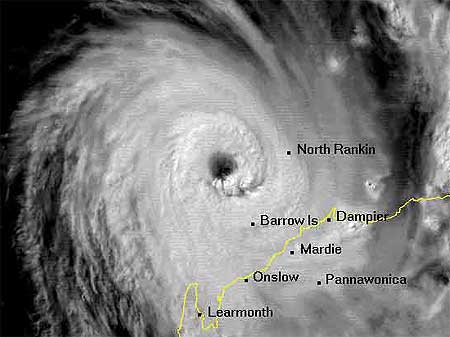
A panel of scientists charged with determining global weather and climate extremes as part of the WMO’s Commission for Climatology (CCl) recently reviewed numerous exceptional wind gusts recorded on Barrow Island during Olivia. They concluded that five peak gusts, ranging from 186 mph to the peak of 253 mph were indeed accurate. The other gusts measured 229 mph, 233 mph, and 215 mph, lending credibility to the record wind. The scientists concluded that a mesovortex in Olivia’s well-defined eyewall was likely the cause of the extreme winds.
But the record wind went unnoticed for a decade before the panel happened upon the observations from Barrow Island. Already stunned by losing the record wind gust distinction, Mt. Washington Observatory Executive Director Scot Henley told the Associated Press he was shocked the record remained hidden so long.
“Somehow it fell through the cracks and the Australians didn’t think it was a big deal,” he stated. “We hear that, and it kinds of blows our minds.”
Well, it might not have been quite as simple as that, as Jeff Masters of Weather Underground reports in his blog. He writes that Australia’s Bureau of Meteorology (BOM) was notified about the gusts, but considered them suspect since they were extraordinarily high for a 145 mph tropical cyclone, and because the accuracy of the equipment used to measure the gusts was unknown. Even after a paper on the extreme wind was written in 1999, the data remained in wait another 10 years until someone with the BOM resurrected it and brought it to the attention of the CCl. Read more about why it took 14 years for the record wind to be recognized.
The CCl panel determined the instrument that measured the record wind was a “heavy duty three-cup Synchrotac anemometer,” its report states. It was located near the center of Barrow Island and positioned 33 feet (10 m) above ground level and 210 feet (64 m) above sea level in relatively open terrain. Guy wires stabilized the cyclone-rated Hills telescoping mounting tower, and the anemometer was found to be regularly inspected and calibrated.
According to Wikipedia, Barrow Island, which is slightly larger than Brooklyn, New York, was uninhabited until the 20th century. Oil was discovered there in commercial quantities in 1964 and subsequent drilling resulted in Barrow Island becoming Australia’s leading producer of petroleum and natural gas. The anemometer that measured the world’s new fastest surface wind is owned and maintained by Chevron.
A report of the record wind is posted on the Arizona State University Web site. It contains additional details of Olivia’s record event and names the report’s panel of experts within CCl.
AMS on NPR
NPR reporter Jon Hamilton was in Atlanta for the AMS Annual Meeting, searching for the effects of the hacked climate scientists’ emails. He interviewed a number of people at the meeting, with the resulting segment (transcript and audio here) that aired on Morning Edition on Thursday.
The quoted scientists were: Kevin Goebbert, Valparaiso University; Dave Gutzler, University of New Mexico; Chris Folland, UK Met Office; Marcus Williams, Florida State University; and Bill Hooke, AMS Policy Program.
An Expanding Security Role for the Military
On Tuesday, the Introduction to Environmental Security and Climate Change presented by John Lanicci and James Ramsay of Embry-Riddle Aeronautical University broadened the scope of national security issues to include extreme environmental events and climate anomalies, the destabilizing effects of these events, and the potential security implications.
In this clip, Lanicci discusses the accompanying chart from the U.S. Transportation Command.
NPOESS Imager Delivered
This week, while the National Polar-orbiting Operational Environmental Satellite System was a hot topic at the AMS Annual Meeting, Northrop Grumman delivered a critical NPOESS sensor, the Visible Infrared Imager Radiometer Suite (VIIRS).
The VIIRS aboard NPOESS will provide highly detailed imagery of clouds, vegetation, snow cover, dust storms, and other environmental phenomena.
“The delivery of VIIRS enables us to move ahead on an advanced system consisting of spacecraft, sensors, and a ground segment that is already well underway,” said Dave Vandervoet, NPOESS program manager for Northrop Grumman Aerospace Systems. “This program made terrific progress last year, and the vast majority of the development risk is behind us now. The sensor that was delivered will be integrated on to the NPOESS Preparatory Project spacecraft, which will be launched next year.”
Raytheon built the instrument under contract to NPOESS prime contractor, Northrop Grumman.
A second VIIRS flight unit scheduled for deployment on the first NPOESS spacecraft, known as C1, is progressing as well.
For samples of next-generation satellite imagery from NPOESS, check out the NexSat web page from Naval Research Labs in Monterey, which was described in the April 2006 issue of BAMS.

A Plea for Collaboration
Wednesday’s panel discussion on the Evolution of Hydromet and Climate Services emphasized the need for the health and climate communities to work together more closely. In this context, Kris Ebi of the IPCC made a direct request to federal agencies and journal editors about papers involving multiple disciplines. Listen to the clip here.
Weather and Water at the Robert E. Horton Lecture
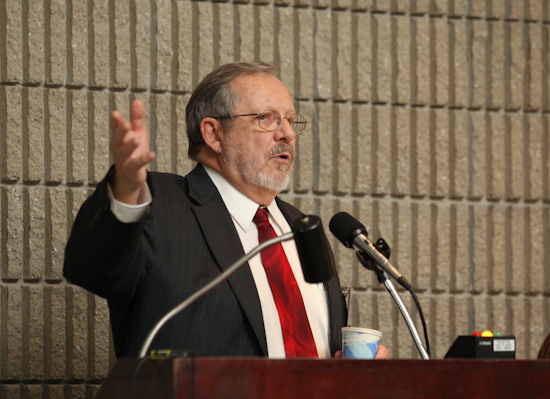
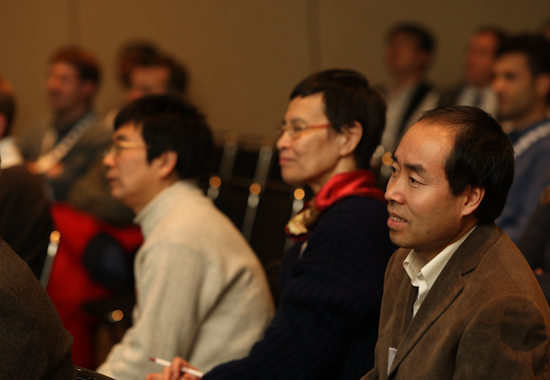
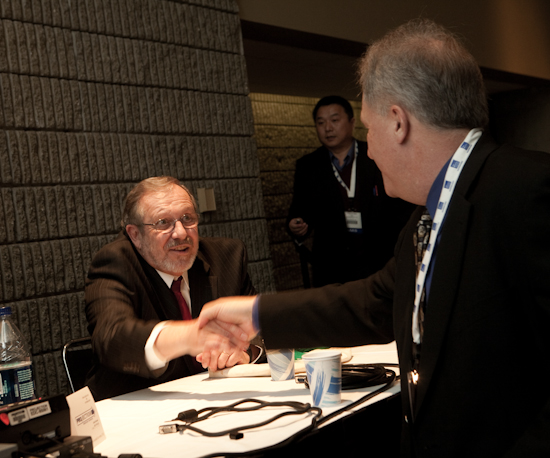

International Dinner Provides Global Flavor
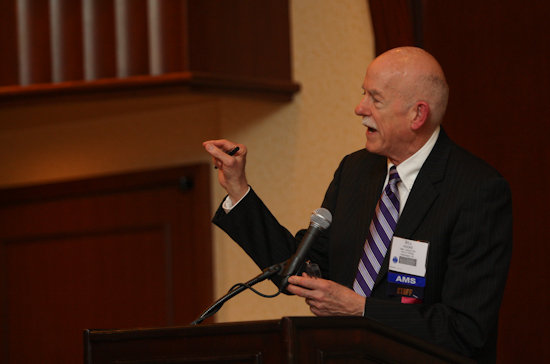
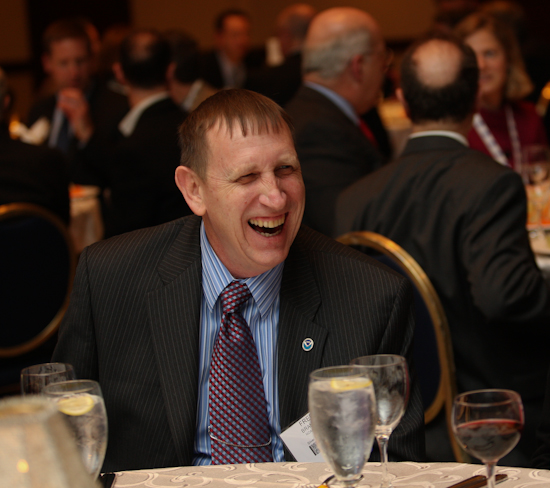

"An Incredible Experience"
The AMS/UCAR Congressional Science Fellowship is a unique opportunity for scientists to become involved in the policy process on Capitol Hill. On Tuesday, the current AMS fellow and two former fellows gathered to discuss some of their experiences and dispense advice to potential applicants.
The 2009-10 AMS Congressional Fellow is Jonah Steinbuck, who received his Ph.D. in environmental fluid mechanics and hydrology from Stanford University in 2009. Steinbuck describes his work as a fellow for Representative Edward Markey (D-MA) in the Select Committee for Energy Independence and Global Warming as an “incredible experience.”
Steinbuck noted that he chose working with Markey and the Select Committee for a number of reasons: 1) because of his interest in climate policy and his belief that the Select Committee gave him the best opportunity to pursue that interest, 2) because “Chairman Markey is one of the leaders in environmental and energy issues,” and 3) because of the Select Committee staff, which allows him to be “a sponge absorbing information” from “some of the best climate policy talent on Capitol Hill.”
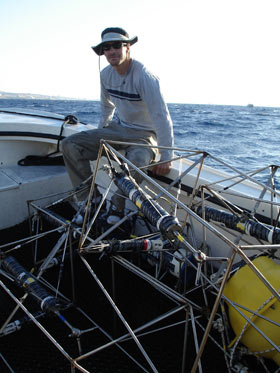
Perhaps the highlight of Steinbuck’s fellowship thus far was his recent trip to the Copenhagen Summit, where he received a credential from the State Department and was able to attend the talks. Steinbuck was particularly impressed with the dramatic conclusion when President Obama negotiated the final text of the agreement with other world leaders.
While the Select Committee awaits the final results of the conference, Steinbuck is also currently tracking EPA regulation of greenhouse gases while monitoring a number of bills proposed to block such regulation from stationary sources.
Past fellows Stephanie Herring and Michael Morgan also spoke about their Congressional Fellowship experiences. Herring, who like Steinbuck served under Congressman Markey in the Select Committee for Energy Independence and Global Warming, is currently working on climate science and service issues as a climate policy analyst in the office of the Department of the Deputy Undersecretary at NOAA. During her time as a fellow, Herring worked on the original version of the legislation that eventually became the Clean Energy and Security Act (also known as the Waxman-Markey Bill). She called the fellowship an ideal transition into new pursuits and in this clip responded to a question on how her fellowship experience enhanced her Ph.D. studies.
Morgan, currently a professor at the University of Wisconsin, recalled his time in Senator Benjamin Cardin’s (D-MD) personal office with fondness, even though, as he explained here, it was the exact opposite of what he originally thought he was looking for in a fellowship experience. Morgan explained that one of the most important things he learned on Capitol Hill was that “science is not enough”–senators must consider all their legislative priorities and their constituents’ priorities and determine how science fits into that framework.
The speakers cited numerous characteristics that Congressional Fellowship applicants should have: analytic skills, interpersonal skills, awareness of federal policy, an understanding of the role and limits of science in federal policy, diplomacy and political acumen, a sense of ethics, and perhaps most importantly, a legitimate interest in policy that has been displayed in their academic career. They noted that the competition for the fellowship is considerable and that the scientific records of most applicants is outstanding.
Applications for the 2010-2011 fellowship are due by February 10.
